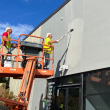State & Local Government Technology Outlook
The National Association of State Chief Information Officers conducted a survey, which assessed state CIOs’ thoughts on a wide array of topics that affect their roles as public sector technology and business leaders in today’s modern world. CIOs identified digital government services and the citizen experience, legacy modernization, broadband expansion and adoption, and expansion of remote and hybrid work options as their highest-priority to implement. Cybersecurity also ranked as the top concern for state governments, which was captured in the 2022 Deloitte-NASCIO Cybersecurity Study.
In the current technology landscape it’s important for state and local government leaders to not only realize the need for legacy equipment modernization and improving citizen experience but to make these priorities actionable. While the influx of funding toward community broadband, for example, has made Wi-Fi publicly available to citizens, state and local government agencies often have to go through a tedious, long, and competitive bid process to acquire technology needs. Fortunately, participants of OMNIA Partners, have access to a lead agency model, in which contracts have already been competitively solicited and publicly awarded, making the process compliant and much faster to procure technology goods and services through suppliers like DLT Solutions. Participants save time and money on technology needs with the ability to piggyback on a previously awarded contract.
Technology Outlook for 2023
Now that we have presented a solution to acquire technology needs with the help of cooperative purchasing, let’s deep dive into the 5 trending technology needs for state and local government in 2023.
- Digital government has quickly become a must-have for government services. These efforts are predicated upon accelerated citizen demand, which is a focal point for public sector and has become highly dependent on tools that can expedite services and enhance efficiency. The next generation of the citizen experience is driven by technology that can create personalized, user-friendly government services, such as e-portals for driver’s license renewals and chatbots for public health service delivery. Cloud adoption, artificial intelligence-based automation tools and secure architecture that utilizes development platforms, such as low-code/no-code software, are now an integral part of enterprise sustainability.
- Legacy modernization has been a longstanding issue for state and local governments. From both an enterprise and risk management standpoint, legacy modernization helps reduce limitations and challenges that state governments face daily. Legacy system modernization will be necessary to ensure the government enterprise is resilient and sustainable.
- Bridging the digital divide and corresponding equity gaps has been a high priority nationwide and will continue to stay top of mind for state and local leaders. The issue of the digital divide is paramount in achieving equality for all citizens. Propelling this initiative forward is the influx of federal broadband funding.
- For state and local leaders, the topic of workforce challenges has been one of utmost concern. State governments are struggling with issues around staff recruitment and retainment, facing difficulties navigating post-pandemic expectations. Hybrid and remote work models are now quite common and are influencing the newest generation of workers to seek flexible employment. Workforce challenges around cybersecurity have triggered additional cause for alarm. As the talent gap persists, state leaders tasked with overseeing network security are facing increasing dependence from local government.
- Following suit with the national cybersecurity agenda, cybersecurity continues to stay top of mind for state and local leaders. As modernization and digitization efforts continue to define the current landscape, cybersecurity risks also continue to grow, putting our country’s infrastructure at elevated risk. Many states are addressing cybersecurity issues through a “whole-of-state” approach that focuses on strengthening communication channels with federal and local governments and school districts utilizing robust resources, state policy and governance, emergency management and creating a team mentality.
In 2023, technology investments will be geared towards solutions specializing in sound security measures such as keeping operating systems up to date, software and firewall protections, securing a reliable backup system, cyber training for staff and testing for vulnerabilities, systemwide multi-factor authentication (including for remote work), continuous security monitoring, multifactor authentication, encryption, and cloud backup processes.
Fortunately, for today’s state and local government leaders, our modern world has and will continue to encourage the public sector to take on more of an innovative enterprise role, rewarding states and localities that have fully embraced modernization. OMNIA Partners and DLT Solutions are here to help ensure your agency is up to date with technology needs to make your operations secure for your employees and citizens alike. For more information on the technology solutions available through our cooperative contracts with DLT Solutions, contact us today!
ABOUT DLT AND OMNIA PARTNERS
For more than 25 years, DLT Solutions has been dedicated to solving public sector IT challenges. Participants can utilize the OMNIA Partners cooperative contract with DLT Solutions to save time and money on IT products, services, and solutions. Discover the entire OMNIA Partners cooperative contract portfolio today for all your procurement needs. Not a participant? Join us today.
This article was originally published by DLT Solutions, a TD Synnex Public Sector Company and can be found in its entirety here.
Brought to you by:





















